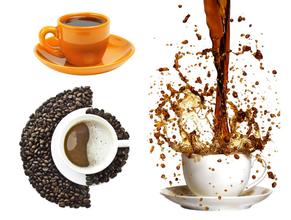Professional introduction of all kinds of coffee beans
Cuba maragogype elephant bean green bean
Elephant bean, giant coffee bean (Elephant bean), it is three times larger than other coffee beans or more, taxonomic name Maragogype, from Brazil (Bahia) state Maragogype (Maragogype) county, where the giant coffee bean was first established taxonomically in 1870, is an Arabica derived species (hybrid variety). Cuba, the largest island in the Caribbean Sea, is long and narrow, reaching 1200KM from east to west, with mountains concentrated at both ends. It has a tropical climate. The language is Spanish and English is also common. It is a communist state. The only country in the world where unemployment is prohibited by law.
Kenya AA Green Bean
Coffee arrived in Kenya in the 19th century, when Ethiopian coffee drinks were imported to Kenya via South Yemen. But it wasn't until the early 20th century that bourbon coffee trees were introduced by the St. Austin Mission. Kenyan coffee is mostly grown at altitudes of 1,500 to 2,100 meters and harvested twice a year. To make sure only ripe berries are picked, people have to make about seven rounds through the woods. Kenyan coffee is grown by smallholders who harvest the coffee and send it fresh to a cooperative washing station, which sends the washed and dried coffee to the cooperative in the state of "parchment beans"(i.e. beans covered with an endocarp)("parchment beans" are the final state of the beans before peeling). All coffee is collected together and growers charge an average price based on its actual quality. This method of buying and selling generally works well and is fair to both growers and consumers.
Hawaii Kona Extra fancy kona raw beans
To be considered a world-class coffee-producing region, six important factors must be included: soil quality, altitude, sunshine, cloud cover, rainfall and slope. Hawaii is blessed with these six ingredients to produce the best and most respected coffee in the world. Soil: The rich tropical volcanic soil of Hawaii provides the nutrients of the dense Kona coffee tree. Altitude: The right altitude between 2100 and 3600 meters and the cool moonlight promote the slow ripening of Kona coffee fruits and create a rich, moist taste.
Ethiopia Washed Yirgacheffe Coffee Green Bean
Medium to pointed (delicate) acidity and medium body, smooth and well balanced cup with a creamy, buttery flavor. The Cream of the Ethiopian Crop with real Mocca flavor. Yerga Coffee is a representative of East African specialty coffee, with a very special, unusual citrus fruit and floral aroma, making Yerga Coffee one of the most distinctive coffees in the world, relatively rare and expensive, produced in Ethiopia Sidamo Province (Sidamo) 4000 feet above sea level, in a relatively high and narrow area. Yerga Coffee is a high quality coffee that is difficult to reach in ordinary mocha, and it is also an excellent representative of African washed coffee.
Ethiopia mocha green bean
Arabica, home of coffee, grows at high latitudes and requires a lot of manual care. Here is the famous Ethiopian mocha, which has a similar acidity to wine, aroma, and yield. Ethiopia also exports coffee through the port of Mocha in neighbouring Yemen, across the Red Sea, so Ethiopian sun-cured coffee is often referred to as mocha. Canada in the southwest and West Tamar in the south are the main producing areas. In addition, the Eastern Highlands are also known for coffee. The beans are small and fragrant, and "Hara. Mocha is a special name for "Longu Bailey", which has a unique flavor and is usually only called "mocha". Its specifications are divided into G (grade) 1-G8 according to the ratio of defective beans mixed.
Tanzania PB coffee green bean / Peaberry garden bean, usually the best
Most Tanzanian beans are grown in Mr. Kilimanjaro and Mt. Meru near the northern Kenyan border. The Meru area is usually called "Krimanjaro" and occasionally named after Moshi or Arusha. On the south side of the border, a little washed arabica beans are also produced, named after the nearby city of Mbeya or the distribution center of Pare. The classification is similar to Kenya, with English letters distinguishing sizes. Most Tanzanian beans have typical African bean characteristics. The better crimenjaro is similar to regular Kenya, has a thick texture, is usually milder in acidity than Kenya, and evenly stimulates the middle and lateral taste buds at the back of the tongue. It tastes a bit like a tomato or soda. As for the southern beans, they are comparable to the second-grade washed mocha, with a soft and pleasing weak acid, a round taste, and a medium texture. Beans from neighbouring Malawi also have qualities similar to those of Tanzanian beans.
Colombia SUPREMO Colombia coffee green bean SUPREMO
Colombia coffee is one of the few plain coffees sold worldwide under its name. In terms of quality, it has earned accolades that no other coffee can match. The country is the world's largest exporter of arabica coffee beans, while robusta coffee is rarely grown. It is also the world's largest exporter of washed beans. Colombia is more concerned with product development and production promotion than other producing countries. It is this, coupled with its superior geographical and climatic conditions, that makes Colombia coffee delicious and famous all over the world.
Brazil santos coffee green bean
Although Brazil produces 30 to 35 percent of the world's coffee annually, ranking first in the world, no Brazilian bean is considered top-class coffee. Coffee trees abound in the south of Brazil, but only Santos can be brought to the table; most of the other poorly processed beans are used for instant coffee and easy-to-open coffee. Sandos coffee grows in the Sao Paulo area, named after the export port Sandos, and is a descendant of the Arabica tree that came from the Island of Bourbon (today's French Reunion Island, located in the Indian Ocean east of Madagascar) in the 18th century. Bourbon)。Before the age of three to four, the boubon coffee tree produces small, twisted beans called boubon sandos, the highest Brazilian beans, often referred to as brazil in cafes.

Important Notice :
前街咖啡 FrontStreet Coffee has moved to new addredd:
FrontStreet Coffee Address: 315,Donghua East Road,GuangZhou
Tel:020 38364473
- Prev

The difference between mocha and latte
Mocha (Mocha Coffee) is produced in Ethiopia. Beans are small and fragrant, with strong sour and mellow taste, moderate sweetness and special flavor. Washed coffee beans are well-known high-quality coffee, often drunk on a single basis. However, if mixed coffee can be blended, it is an ideal comprehensive coffee with ideal flavor. Characteristics: 1, taste: slightly sweet with soft acidity, sweetness has its own unique round ripe
- Next

Popularization of professional coffee knowledge | what is honey treatment?
Let's analyze each method of raw bean treatment one by one: 1. Natural solarization (Natural/Dried-in-the-Fruit): the process of this method is the simplest. The fruit begins the process of sun drying without treatment after picking. This is the oldest method of treatment in existence. This method is still used in places such as Ethiopia and Brazil. The natural solarization method is used in
Related
- Beginners will see the "Coffee pull flower" guide!
- What is the difference between ice blog purified milk and ordinary milk coffee?
- Why is the Philippines the largest producer of crops in Liberia?
- For coffee extraction, should the fine powder be retained?
- How does extracted espresso fill pressed powder? How much strength does it take to press the powder?
- How to make jasmine cold extract coffee? Is the jasmine + latte good?
- Will this little toy really make the coffee taste better? How does Lily Drip affect coffee extraction?
- Will the action of slapping the filter cup also affect coffee extraction?
- What's the difference between powder-to-water ratio and powder-to-liquid ratio?
- What is the Ethiopian local species? What does it have to do with Heirloom native species?

